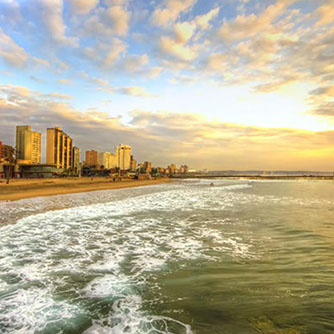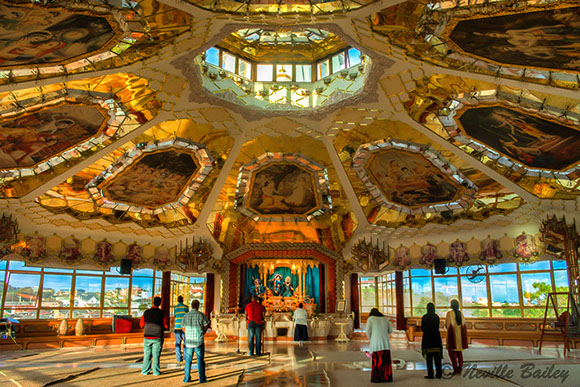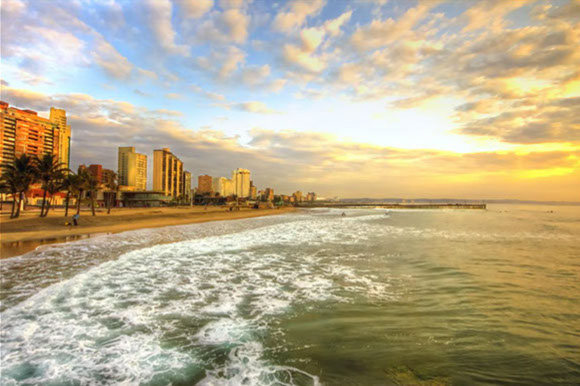 Durban Days
Durban Days
"If you engage only with the obvious touristy spaces in Durban, I don’t think it’s a particularly exciting city. But if you find the more edgy and liminal spaces, it is a place like nowhere else in the world." So says Peter Machen, arts writer and newly appointed manager of the Durban International Film Festival. With a slew of big events hitting the city this month, we ask him to explain himself…
My Durban is not the Durban of the Vodacom July horse race. It is not the Durban of Top Gear eventing. It is not the Durban of 'world class' shopping centres or rugby matches attended by tens of thousands of people. In a way my Durban belongs entirely to me. It is my reality, and of course it is like nobody else's. But I wish I could transmit it to you. The water is warm. All year round. And some days that alone is enough, as you sink into the generous arms of the Indian Ocean and try to stay beyond the reach of it's errant currents. Sometimes, floating in that salty water, staring at the indigo sky with vision made blurry and body tired from an afternoon of swimming, is all that I need. But there is so much more.
Located at the edge of the world and – in our infinitely connected and newly networked planet – also near the centre, Durban is sold primarily as sun, sand, sea and commerce, with a backdrop of cultural intrigue. But the reality is that for most visitors, the city's cultural reality maintains that intrigue, providing an ambient mirage of images that exists solely to suggest that the global traveller is in a different place. It is a veneer with which they do not need to engage.
Yet for those who move beyond the sunny holidayed surface of Durban and into the real city, shimmering riches emerge. For Durban is a city like no other, a place where multiple cultures collide in a Rorschach painting of histories and colonialisms and faiths. The result is beautifully kaleidoscopic, rendered against a backdrop that looks much like paradise, infinitely blue and verdant with vegetation that seems to be in constant bloom.
The truth is that if Durban were another kind of city, tourists would be regularly found in large numbers at the magnificent if slightly tawdry Temple of Understanding in Chatsworth, grabbing an authentic curry at Patels in Grey Street, or exploring the the Inanda area just North of Durban which gave birth to South Africa's liberation movement. But for some reason, even those connections aren't made for most visitors, and many of the most obviously interesting offerings remain marginal activities (although local tour company Streetscene, who regularly deliver tourists to some of the attractions that the city's iconography promises, are are starting to change that).

Yet these under-explored archetypes which dominate the imaging of Durban have real value. They are genuinely enriching experiences in the best touristy way, the kind of experience that locals still enjoy. The bunnychow (a fiery curry in a hollowed-out loaf of bread) and Hindu temple visits, for example, are both interesting local experiences that are not generally experienced by many visitors. I've been to Hindu Temple sites countless times, for example, and it is rare to encounter visitors from beyond the city. Similarly, when I am walking through the city's numerous arcades and back alleys, or standing on the edge of a Shembe temple made only from a border of white-washed stones, I am often the only middle-class person around, the only person who is there to explore a reality other than their own.
Then there are the less obvious options for the more wayward travellers. Even with some degree of encouragement, visitors might not be drawn to the hinterlands of the bayhead, where the stark industrial beauty of the harbour slices itself into the natural grandeur of the bluff. They might not find their way to the Britannia Hotel, which was built overlooking the banks of the Umgeni River from which it is now separated by a giant hulk of freeway interchange but which still serves some of Durban's finest curries. They might not get to savour the drive along Riverside Road where indigenous foliage gives way to the banks of the river that leads out into the sea. They might not find their way to the Winston Hotel where local expressions of punk-rock are as vibrant as anything the Sex Pistols ever produced. They might not find themselves on the edges of a Shembe church service next to an abandoned car lot on Sunday morning or in a YMCA hall at midnight listening to the beautiful a cappella sound of isicathimiya that Ladysmith Black Mambazo made famous. They might not find themselves breaking into deserted quarries at the break of day, or wandering through Umhlanga's palm forest.
But if they do, they'll begin to find their own Durban in just the same way that I have found my Durban, and in doing so, found a place that will be forever at the core of my being. If you spend a little time drinking from it's lifeblood, the city will become a part of you.
So, if you're a visitor to Durban, don't abandon the city's golden sands and Indian Ocean. These things have immense value too. But if you get out of your car, and move beyond the shopping centres and the hotels and their generic global glamour, you'll find things you've never seen before, and, in all likelihood, won't see anywhere else in the world.
Side Bar 1: 10 Essential Durban Experiences
1. Swimming in Battery Beach on the Golden Mile. Best done at sunrise, sunset or all afternoon long.
2. Watching a Shembe baptism at sunrise, respectfully, from the distance. On Sundays, all along eThekwini's coastline, although Battery Beach is a guaranteed spot.
3. A cocktail on top of the Roma Revolving Restaurant on the Esplanade (Margeret Mncadi Avenue).
4. iSicathimiya at the YMCA in Charlotte Maxeke Street (formerly Beatrice Street) on Saturday nights from midnight till dawn. Be warned, if you volunteer to be a judge, you have to stay till morning.
5. Punk, hard rock and a generous dose of counter culture at the Winston, Durban's bastion of all things alternative. In Clark Road, Glenwood, every night.
6. Driving Around the back of the harbour on a Sunday morning. While many areas have become restricted over the last few years, there is still plenty of industrial beauty to peruse without a permit.
7. Curry in the Grey Street area. Try Patels in Dr Yusuf Dadoo Street (formerly Grey Street) or one of the two branches of Little Gujerat in Dr AB Goonam Street (formerly Prince Edward Street).
8. Shopping for fresh produce in Warwick Junction.
9. Exploring the Cato Manor area, just north of the CBD, Durban's equivalent of District 6 or Sophiatown.
10. The Durban International Film Festival. Now in it's 35th Year, DIFF is Africa's largest and most significant film festival. See you there. I'll save you a seat!

Sidebar 2: The Best Places to go after a movie at DIFF
Spiga D'Oro: Durban's most popular Italian restaurant is just up the road from the festival hub on the beachfront. With a Tuscan-style courtyard, Spiga is open till midnight on weekdays and till the early hours of the morning on weekends and holidays.
Cafe Jiran: Just down the drag from the festival hub at the Blue Waters Hotel, Jiran is the perfect place to take a little time out from the festival and watch people instead of movies. Open for breakfast, lunch and dinner. Closes at about 10pm.
The Elangeni Hotel: The newly refurbished Elangeni has committed to keeping their bar open 24 hours a day during the ten days of the festival. Its refined elegance and extended opening hours should make it the de facto watering hole during the festival.
Zataras: This tiny kiosk overlooking Battery Beach sells a range of freshly squeezed juices as well as coffee and light meals.
The I heart DIFF Marquee: For the first time in many years, DIFF has provided a space for festival-goers to relax and a grab a drink or something to eat. Located in front of the Blue Waters Hotel.
This story was first published in Sawubona
© PETER MACHEN 2017